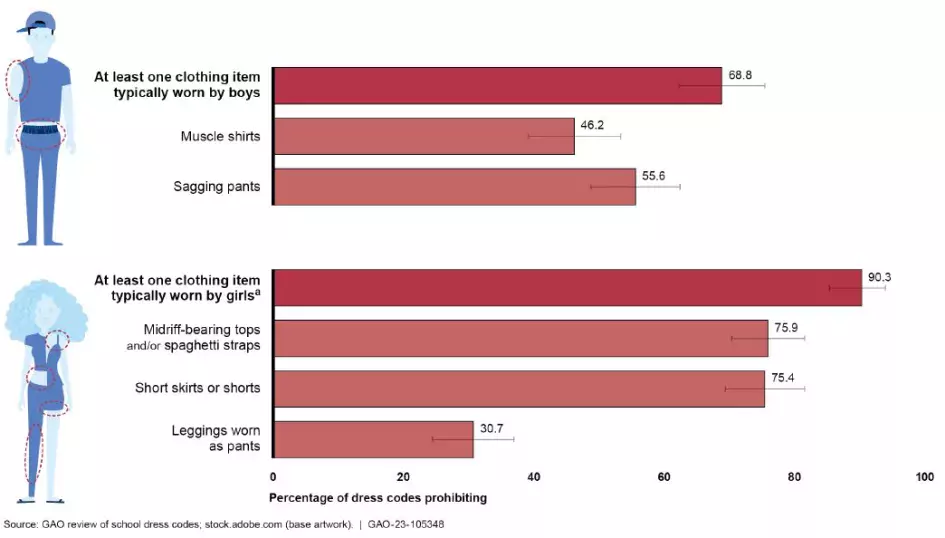Back to School—Obstacles to Educating K-12 Students Persist
Declining test scores, widespread teacher shortages, and steadily increasing hostile behaviors like bullying and hate speech have all left their mark on public school students and teachers over the last few years. Many students, their families, and educators may be wondering what this new school year may bring.
Today’s WatchBlog post looks at our work over the last year on trends in education, including: ongoing teacher shortages, school dress codes and disciplinary actions, and the concerns about whether services in private school are equitable.
Image

K-12 teacher shortages persist
Long-standing concerns about teacher shortages escalated during the COVID-19 pandemic, amid reports of more teachers leaving the profession, fewer new teachers entering, and schools struggling to hire teachers. We looked at this issue by analyzing national data and conducting focus groups with current and former teachers, school district officials, state educational agency officials, and providers of teacher certification programs. We found that while these shortages occurred nationwide, they were most prevalent among schools in the West, urban and rural communities, and in schools predominantly serving Black and Brown children. There were also notable shortages in subjects such as science and foreign languages.
Why are these shortages occurring? School officials we spoke with told us that prospective teachers face high costs in becoming a teacher—including obtaining their own educational degrees and fulfilling state licensing requirements—which often differ among states, making it difficult to recruit across state lines. And teacher salaries may not be enough to comfortably live on, making it more difficult to attract and retain teachers. Similarly, educators and school officials we interviewed consistently cited a widespread negative perception about the teaching profession. Teachers described feeling exploited, demoralized, and unsafe. They've observed increasingly aggressive behaviors from students and parents. Stress, fatigue, deteriorating mental health—those are all pushing current teachers to leave and dissuading others from becoming teachers.
Challenges to Recruiting and Retaining Teachers
Image

What impact does this have on students? For starters, students can’t learn if there is no one qualified to teach them, and we’ve already seen cases where shortages have led to unqualified adults in the classroom or schools temporarily closing. It also puts additional stress on existing teachers and means fewer opportunities to help students who need more attention.
Learn more about these potential impacts on students and what teachers told us about the shortage by reading our report and listening to our podcast with GAO’s K-12 education expert Jackie Nowicki.
How school dress codes can cause disparities among students
School dress codes have recently come under increased scrutiny—both for their content and over whether enforcement is equitable. We recently looked at enforcement of school dress codes and found disparities along gender and racial lines.
We looked at a national sample of school district policies and found that nearly all K-12 public school districts (an estimated 93%) have a policy on student dress. Of these schools, an estimated 90% had policies that specifically prohibit clothing items typically associated with girls. But only 69% prohibit items typically associated with boys. Other dress code provisions, such as those on hair, hair styles, and head coverings, disproportionately affect Black students and those of certain religions, cultures, and identities.
Items Commonly Prohibited by School Dress Codes
Image

In addition to the dress code rules themselves, we also looked at how dress codes were enforced. We found that schools that predominately enrolled Black and Hispanic students enforce their dress codes more than schools that predominantly enroll White students. These schools are also associated with higher rates of discipline for violating dress codes, including removing students from the classroom (e.g. suspensions).
These disciplinary actions against students have resulted in some students, especially girls, feeling less safe in schools. Further, Black girls are three times more likely to be sent to the school office than White girls due to societal perceptions of maturity. To address these issues, we made four recommendations to the Department of Education. These included that Education provide resources to help districts design equitable dress codes, and to collect and disseminate information on the prevalence and effects of informal removals and non-exclusionary discipline.
What about private schools?
So far, we’ve talked about our work on public K-12 schools. But we’ve also looked at some issues facing private schools, which are sometimes entitled to receive federal funding.
For example, in April 2023, we looked at whether private school students eligible for the same federally-funded services as public school students—such as tutoring and English language services—received these services. Federal law requires that states designate personnel to address inquiries and concerns about such services (known as equitable services.)
But when we looked at this issue, we found wide concern with such state positions and their ability to carry out their duties. We surveyed private school and school district leaders, who told us about their concerns, such as workload and that they may not always be independent and impartial in their duties. We also surveyed state officials themselves, who stated that additional guidance and training would be useful to conduct their work. Finally, we looked into the Department of Education’s role in resolving appeals of state equitable services complaint decisions. We found that while Education has 90 days, by law, to investigate such complaints, it has never met this timeframe.
Learn more about our private school work by checking out our full report.
And learn more about our work on the current issues facing K-12 education, by checking out our issues page here.
- Comments on GAO’s WatchBlog? Contact blog@gao.gov.
GAO Contacts
Related Products

GAO's mission is to provide Congress with fact-based, nonpartisan information that can help improve federal government performance and ensure accountability for the benefit of the American people. GAO launched its WatchBlog in January, 2014, as part of its continuing effort to reach its audiences—Congress and the American people—where they are currently looking for information.
The blog format allows GAO to provide a little more context about its work than it can offer on its other social media platforms. Posts will tie GAO work to current events and the news; show how GAO’s work is affecting agencies or legislation; highlight reports, testimonies, and issue areas where GAO does work; and provide information about GAO itself, among other things.
Please send any feedback on GAO's WatchBlog to blog@gao.gov.




